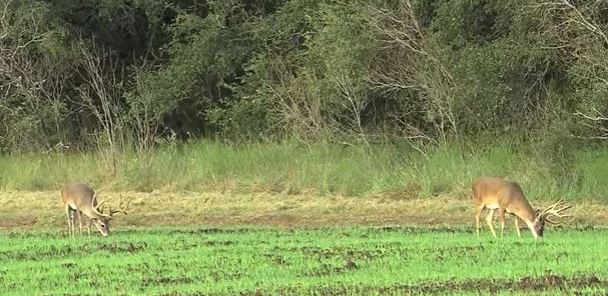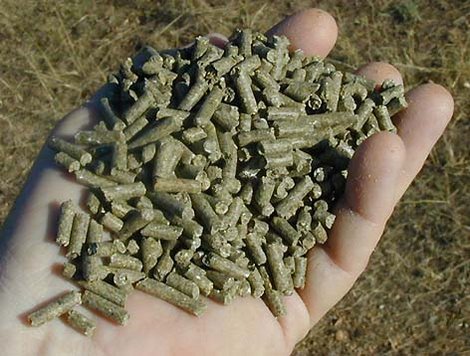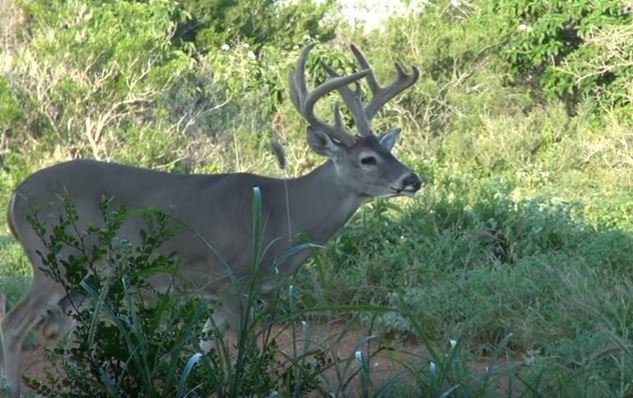A number of hunters, land managers as well as biologists believe that a diet comprised of at least 16 percent protein is needed for white-tailed bucks to achieve maximum antler growth and for does to achieve maximum fawn production. This is true for the most part, but deer can do well during times when natural protein levels are relatively low as well.
Dietary Requirements Vary by Season
Protein levels are always important for white-tailed deer, but protein intake is of most importance to deer during specific times of the year. Those “important periods” differ between bucks and does and coincide with important physiological processes in each.
For antler growth, that important period spans from late winter through the end of the antler-growing season. For fawn production in doe deer, the period when protein levels are most critical is during fetal development and subsequent lactation. Antler growth and fawn survival rates are correlated with protein levels; so more protein means more antler material and higher survival rates.

In general, protein levels are highest in native forage during the spring and fall, the time when plants are actively growing, and are lowest during summer and winter. A dry summer, however, can leave deer at a deficit, somewhat. White-tailed deer, however, can survive consuming low (quality) protein foods, but they do better when dietary protein levels are kept at a higher nutritional plane.
White-tailed Deer Protein Requirements
So the optimal diet for white-tailed deer is one that contains 16 percent protein, but what about the times when protein becomes limited in native plants, such as during the summer and winter months? White-tailed deer can compensate for this seasonal availability of protein through protein recycling, but this means proteins will be used for only the most critical functions first.
Protein recycling allows deer to use sub-16-percent protein food items, such as those in the 8-10 percent range, but their body can break them down and re-combine them, more or less. This process takes additional energy however, so although deer are surviving they are not thriving. This will keep them alive and breathing, but do not expect a bumper crop of antlers, fawns and otherwise healthy deer.

Timing Seasonal Protein Needs
It’s not by coincidence that buck antler growth and fetal fawn development with doe deer coincides with the seasonally-high level of protein found in native vegetation during the spring growing season. Nature has a way of figuring things out and in whitetail the processes that demand the most protein happen during the spring (although it helps to have protein levels stay high into the summer, but that does not always happen).
Dietary requirements change throughout the year. Protein is king during the first half of the year, while energy becomes the coveted calories during the fall. This equates to foods high in carbohydrates and/or fats. It’s during this time of the year that acorns fall, which happen to be high on both counts.
Protein Needed for Antler Growth
Although white-tailed deer can survive a dry spring, bucks will produce antlers that are smaller than their potential (for antler growth) and does may abort fawns prior to birth or abandon them shortly thereafter. High protein levels are not critical for deer survival, but additional protein can definitely increase antler size, as well as fawning rates, in many cases.

However, I’ve seen properties that feed free-choice protein to their deer year-round fall victim to low fawn recruitment. Why? Because deer will eat from a feeder, but they still pick up environmental cues that tell them how they should act. If habitat is in poor condition from too many deer or drought conditions, deer pick up on the environment — and that dictates their behavior.
Meeting the Dietary Needs of Deer
If interested in supplementing white-tailed deer remember that summer and winter are the critical times with regards to protein availability. It is typically during these times that protein levels are low. Providing additional foods high in protein during the spring and fall will enhance the body condition of the deer on using your property.
Deer herds in better physical condition grow larger antlers and raise more fawns than they otherwise would. White-tailed deer managers will get the most bang for their buck if they have high protein foods (at least 16 percent) available during the late winter (post rut) through green-up and then again during the late summer until acorn drop.
VIDEO: Supplemental Feeding Considerations

I have tried feeding protein mixed in with my corn and found that only the protein is left on the ground. I have put protein feeders out and no deer will eat from them. What else can I do to get deer to consume protein pellets?
I live in TN and have the same problem. We put out Trophy Rocks right by the Boss Buck protein feeders and the deer kicked them around like footballs and ate them up but never touched the 50-50 mix of protein pellets and feed corn. Then we put out trace mineral blocks (a lot cheaper) and the deer are using them but still not feeding on the protein. I started in late February. The turkeys come and pick out the corn and the coons are having a ball every night, but no deer eat. Somebody has to have solved this riddle. Help!
JStone & Rick, mixing items with corn is the right course of action when introducing new foods to white-tailed deer. Timing is also important. Late February may be too late in the winter to introduce pellets if you are at lower latitudes. Once green-up kicks in deer will not eat protein pellets, even in areas where they have been fed them for years. The best time to start is probably mid-winter and mid-summer (as long as it’s not a wet summer, then all bets are off!).
Protein is important for growing white-tailed deer, whether it be bucks, does or fawns. We manage the habitat on our property but also provide supplements during the late winter. It is important to keep all deer in good body condition as they go into spring. We’ve seen bump in fawn survival and overall buck quality because of it.